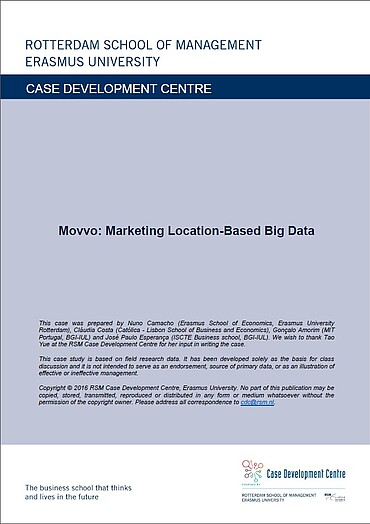description
The Portuguese startup Movvo uses technology to detect consumers’ movement patterns in enclosed spaces. Now ready to bring its technology to the market, Movvo has to decide how to create value for which customer segment, how to overcome resistance to adoption, and how to ensure monetization.
Citation Note
Based on field research; 22 pages.
Follow the 'handle' link to access the Case Study on RePub.
For EUR staff members: the Teaching Note is available on request, you can contact us at rsm.nl/cdc/contact/
For external users: follow the link to purchase the Case Study and the Teaching Note.
Objective
This case can be effectively used in several contexts. It can be taught in an undergraduate course in marketing or as an introductory MBA course in marketing strategy to illustrate key concepts in segmentation, targeting and positioning of new brands, competitive analysis and the criticality of understanding the pros and cons of a technology in different markets for market entry decisions. The case allows the instructor to go into great depth in the discussion of segmentation and positioning issues, and use data and market intelligence to make evidence-based decisions (e.g. usage of perceptual maps to discuss competitive positioning). For longer discussions the instructor may also use the context and decisions in the case to teach students how to construct a go-to-market plan, allowing the discussion to go into more strategic issues.
Abstract
Diana Almeida, Roberto Ugo and Suzy Vasconcelos, the three founders of Movvo, are confident that their technology to detect consumers’ movement patterns in enclosed spaces is now ready to go to market. Yet, to ensure a successful launch they need to solve several challenges. First, Movvo’s founding team needs to carefully decide which customer or customers to target with their technology. Should they develop services to better understand how consumers shop in retail stores or malls? Or should they focus on transportation and mobility applications (e.g. optimizing passengers’ flow), and if yes target a large market such as different urban transportation modes or a more niche market, such as airports? Second, the team needs to understand the competitive landscape and decide how to position their technology vis-à-vis existing competitors. Third, Movvo needs to devise a convincing value demonstration strategy. Specifically, Movvo needs to convince prospective customers of the value that their technology creates (not only “big data”, but essentially “increased wisdom”) while, at the same time, reducing concerns with privacy-related issues. Finally, Movvo needs to convince investors that it is able to monetize its technology. What pricing and business model will they propose? In sum, the case allows the discussion of typical key decisions faced by high-technology startups, namely the importance of careful, evidence-based, value creation strategy (segmentation, targeting and positioning), but also of a robust value demonstration (e.g. to overcome resistance to adoption) and value extraction strategies (to ensure the startup is able to adequately monetize its technology).
